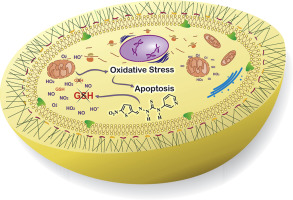当前位置:
X-MOL 学术
›
Chem. Biol. Interact.
›
论文详情
Our official English website, www.x-mol.net, welcomes your feedback! (Note: you will need to create a separate account there.)
Thiophene-thiosemicarbazone derivative (L10) exerts antifungal activity mediated by oxidative stress and apoptosis in C. albicans.
Chemico-Biological Interactions ( IF 5.1 ) Pub Date : 2020-02-28 , DOI: 10.1016/j.cbi.2020.109028 Luiz Nascimento de Araújo Neto 1 , Maria do Carmo Alves de Lima 2 , Jamerson Ferreira de Oliveira 2 , Edson Rubhens de Souza 2 , Suellen Emilliany Feitosa Machado 2 , Gláucia Manoella de Souza Lima 3 , Maria Daniela Silva Buonafina 4 , Fábio André Brayner 5 , Luiz Carlos Alves 5 , Jana Messias Sandes 5 , Márcia Vanusa da Silva 6 , Maria Carolina Accioly Brelaz de Castro 7 , Rejane Pereira Neves 4 , Francisco Jaime Bezerra Mendonça-Junior 8
Chemico-Biological Interactions ( IF 5.1 ) Pub Date : 2020-02-28 , DOI: 10.1016/j.cbi.2020.109028 Luiz Nascimento de Araújo Neto 1 , Maria do Carmo Alves de Lima 2 , Jamerson Ferreira de Oliveira 2 , Edson Rubhens de Souza 2 , Suellen Emilliany Feitosa Machado 2 , Gláucia Manoella de Souza Lima 3 , Maria Daniela Silva Buonafina 4 , Fábio André Brayner 5 , Luiz Carlos Alves 5 , Jana Messias Sandes 5 , Márcia Vanusa da Silva 6 , Maria Carolina Accioly Brelaz de Castro 7 , Rejane Pereira Neves 4 , Francisco Jaime Bezerra Mendonça-Junior 8
Affiliation

|
Reactive oxygen species (ROS) cause cell damage and death. To reverse these effects, cells produce substances such as reduced glutathione (GSH) that serve as substrates for antioxidant enzymes. One way to combat microbial resistance includes nullifying the effect of glutathione in microbial cells, causing them to die from oxidative stress. The compound 2-((5-nitrothiophen-2-yl)methylene)-N-(pyridin-3-yl) hydrazine carbothioamide (L10) is a new thiophene-thiosemicarbazone derivative with promising antifungal activity. The aim of this study was to evaluate its mechanism of action against Candida albicans using assays that evaluate its effects on redox balance. Treatment with L10 promoted significant changes in the minimum inhibitory concentration (MIC) values in ascorbic acid and GSH protection tests, the latter increasing up to 64-fold of the MIC. Using nuclear magnetic resonance, we demonstrated interaction of L10 and GSH. At concentrations of 4.0 and 8.0 μg/mL, significant changes were observed in ROS production and mitochondrial membrane potential. The cell death profile showed characteristics of initial apoptosis at inhibitory concentrations (4.0 μg/mL). Transmission electron microscopy data corroborated these results and indicated signs of apoptosis, damage to plasma and nuclear membranes, and to mitochondria. Taken together, these results suggest a possible mechanism of action for L10 antifungal activity, involving changes in cellular redox balance, ROS production, and apoptosis-compatible cellular changes.
中文翻译:

噻吩-硫代半碳酰胺衍生物(L10)在白色念珠菌中发挥由氧化应激和细胞凋亡介导的抗真菌活性。
活性氧(ROS)引起细胞损伤和死亡。为了逆转这些效应,细胞会产生诸如还原型谷胱甘肽(GSH)之类的物质,这些物质可作为抗氧化酶的底物。对抗微生物抗性的一种方法包括使谷胱甘肽在微生物细胞中的作用无效,使它们因氧化应激而死亡。化合物2-(((5-硝基噻吩-2-基)亚甲基)-N-(吡啶-3-基)肼碳硫磺酰胺(L10)是一种新的噻吩-硫代半碳酰胺衍生物,具有良好的抗真菌活性。这项研究的目的是使用评估其对氧化还原平衡的影响的试验来评估其对白色念珠菌的作用机理。L10的处理促进了抗坏血酸和GSH保护试验中最小抑菌浓度(MIC)值的显着变化,后者的MIC高达MIC的64倍。使用核磁共振,我们证明了L10和GSH的相互作用。在4.0和8.0μg/ mL的浓度下,观察到ROS的产生和线粒体膜电位的显着变化。细胞死亡特征显示在抑制浓度(4.0μg/ mL)下初始细胞凋亡的特征。透射电子显微镜数据证实了这些结果,并表明了细胞凋亡,质膜和核膜以及线粒体受损的迹象。综上所述,这些结果表明了L10抗真菌活性的可能作用机制,涉及细胞氧化还原平衡,ROS产生和凋亡相容性细胞变化的变化。观察到ROS产生和线粒体膜电位的显着变化。细胞死亡特征显示在抑制浓度(4.0μg/ mL)下初始细胞凋亡的特征。透射电子显微镜数据证实了这些结果,并表明了细胞凋亡,质膜和核膜以及线粒体受损的迹象。综上所述,这些结果表明了L10抗真菌活性的可能作用机制,涉及细胞氧化还原平衡,ROS产生和凋亡相容性细胞变化的变化。观察到ROS产生和线粒体膜电位的显着变化。细胞死亡特征显示在抑制浓度(4.0μg/ mL)下初始细胞凋亡的特征。透射电子显微镜数据证实了这些结果,并表明了细胞凋亡,质膜和核膜以及线粒体受损的迹象。综上所述,这些结果表明了L10抗真菌活性的可能作用机制,涉及细胞氧化还原平衡,ROS产生和凋亡相容性细胞变化的变化。
更新日期:2020-03-02
中文翻译:

噻吩-硫代半碳酰胺衍生物(L10)在白色念珠菌中发挥由氧化应激和细胞凋亡介导的抗真菌活性。
活性氧(ROS)引起细胞损伤和死亡。为了逆转这些效应,细胞会产生诸如还原型谷胱甘肽(GSH)之类的物质,这些物质可作为抗氧化酶的底物。对抗微生物抗性的一种方法包括使谷胱甘肽在微生物细胞中的作用无效,使它们因氧化应激而死亡。化合物2-(((5-硝基噻吩-2-基)亚甲基)-N-(吡啶-3-基)肼碳硫磺酰胺(L10)是一种新的噻吩-硫代半碳酰胺衍生物,具有良好的抗真菌活性。这项研究的目的是使用评估其对氧化还原平衡的影响的试验来评估其对白色念珠菌的作用机理。L10的处理促进了抗坏血酸和GSH保护试验中最小抑菌浓度(MIC)值的显着变化,后者的MIC高达MIC的64倍。使用核磁共振,我们证明了L10和GSH的相互作用。在4.0和8.0μg/ mL的浓度下,观察到ROS的产生和线粒体膜电位的显着变化。细胞死亡特征显示在抑制浓度(4.0μg/ mL)下初始细胞凋亡的特征。透射电子显微镜数据证实了这些结果,并表明了细胞凋亡,质膜和核膜以及线粒体受损的迹象。综上所述,这些结果表明了L10抗真菌活性的可能作用机制,涉及细胞氧化还原平衡,ROS产生和凋亡相容性细胞变化的变化。观察到ROS产生和线粒体膜电位的显着变化。细胞死亡特征显示在抑制浓度(4.0μg/ mL)下初始细胞凋亡的特征。透射电子显微镜数据证实了这些结果,并表明了细胞凋亡,质膜和核膜以及线粒体受损的迹象。综上所述,这些结果表明了L10抗真菌活性的可能作用机制,涉及细胞氧化还原平衡,ROS产生和凋亡相容性细胞变化的变化。观察到ROS产生和线粒体膜电位的显着变化。细胞死亡特征显示在抑制浓度(4.0μg/ mL)下初始细胞凋亡的特征。透射电子显微镜数据证实了这些结果,并表明了细胞凋亡,质膜和核膜以及线粒体受损的迹象。综上所述,这些结果表明了L10抗真菌活性的可能作用机制,涉及细胞氧化还原平衡,ROS产生和凋亡相容性细胞变化的变化。

























 京公网安备 11010802027423号
京公网安备 11010802027423号